- Home
- Products
- Resources
- About Us
- Core Material
- Contact Us
 Loading
Loading
 Loading
Loading

In the previous Understanding lead aprons article, the concept of lead equivalence was introduced, and it was shown how the different materials that are used to attenuate the x-ray radiation in a “lead apron” can affect the lead equivalence. In this article the measurement methods used to determine lead equivalence and the effect that these methods can also have on the results obtained will be scrutinised. The measurement methods followed are prescribed in several international standards related to protective garments and equipment, and whilst details of these methods will be of limited interest to readers, there are several key messages concerning lead equivalence that emerge from the details, and should be noted.
To recap from last month’s article, the lead equivalence of a protective garment can be defined as the thickness of pure lead that is required to produce the same measured ratio of attenuation of an incident radiation beam as the test material. What is not stated in this definition though, is how the measurement is performed.
In terms of the measurement set-up, there are two categories of measurement geometry: narrow beam, and broad beam. In a narrow beam set-up, the detector is placed some distance from the x-ray source – usually something like 1 m, and the x-ray beam is tightly collimated (or coned-in) to an area of only a few centimetres square in the plane of the detector (hence the name “narrow beam”). The sample being tested, or lead filters being used as the reference are placed approximately half way between the x-ray source, and the detector. This geometry is shown schematically in Figure 1 below.

The photo-electric interaction process which is responsible for the attenuation of radiation in the apron material also produces fluorescence x-rays. These are emitted in all directions within the apron material, and whilst the majority are re-absorbed in the material a proportion of them will escape the exit side of the material. The narrow beam measurement geometry is designed to measure only the transmitted primary beam and not the fluorescence x-ray scatter produced.
Considering that an apron is worn close to the body, and so the wearer will be exposed to any scatter produced in addition to the transmitted primary beam, the narrow beam geometry does not give a representative measure of the lead equivalence of non-lead material. In the diagnostic x-ray energy region between 30 and 90 keV, the non-lead materials used like antimony produce significantly more fluorescence x-rays than lead, and so the narrow beam measurement geometry over estimates their lead equivalence. Clearly this is not ideal, and a more representative measure is required.
A broad beam measurement geometry will produce a more representative measure of lead equivalence. In a broad beam set-up the x-ray beam is no longer tightly collimated, and the area of radiation impinging on the sample is quite large – typically 20 – 30 cm square. The detector is placed closely behind the material. This geometry is shown schematically in Figure 2 below.

A broad beam measurement set-up most closely resembles the real world exposure circumstances of someone wearing an apron. Ideally then, when assessing lead equivalence of a protective material, a broad beam geometry is desirable, however, the problem has been that broad beam measurements in the laboratory are not easily reproducible between laboratories, and require large pieces of reference lead material, which are not readily available, and are difficult to handle. Recent standards have introduced an alternative measurement set-up (called inverse broad beam geometry) that over comes these problems, and produces the same results as a broad beam set-up.
In the inverse broad beam geometry the x-ray beam remains tightly collimated, allowing the use of small reference lead filters, but the detector is placed closely behind the sample, and has a large area that intersects all of the transmitted x-ray beam. This geometry is shown below in Figure 3.

The inverse broad beam measurement method provides results equivalent to the broad beam measurement method, and so the apron industry now has available to it a viable means of determining lead equivalence that provides a realistic comparison for the non-lead based aprons against aprons comprised predominantly of lead.
The effect of the two fundamental types of measurement – narrow beam and broad beam (achieved through the use of the inverse broad beam measurement method) – can be seen in Figure 4 which shows the measurement data from a popular non-lead apron with a claimed lead equivalance of “0.5 mm Pb”.
It can be seen from the graph in Figure 4 that under narrow beam measurement conditions, the apron just achieves its 0.5 mm Pb lead equivalence (and only around the 80 kV – 90 kV test point for reasons discussed in the previous “aprons” article). In contrast, under inverse broad beam measurement, the apron fails to achieve even 0.4 mm Pb, and would more accurately be described as a 0.35 mm Pb apron, and this for the range from 70 – 110 kVp.

The approximately 20 % reduction in peak lead equivalence under broad beam measurement conditions is typical of conventional reduced-lead, or non-lead aprons that are constructed from a homogenous mixture of elements. If the apron is constructed either totally from lead, or if it is constructed in a layered fashion, with the inner layer nearest the wearer being either lead or the element bismuth , then this behaviour will not occur. This is because the photo-electric fluorescence x-rays produced by the non-lead elements are masked by the exit layer of lead or bismuth, and the inverse broad beam measurement results should match the narrow beam ones.
So where does this leave the prospective purchaser in terms of trying to navigate their way through the issues of lead vs non-lead, and lead equivalence determined according to narrow or inverse broad beam methods?
Well, the lead equivalence behaviour of non- or reduced-lead garments, which was covered in the previous “Understanding lead aprons” article, is an intrinsic aspect of these aprons. Users simply need to be aware of this characteristic when selecting a suitable range of protective garments.
In terms the measurement method used to determine lead equivalence, there are two main standards relevant for Australia and New Zealand: AS/NZS 4543-1(1), and IEC 61331-1 (2nd ed.)(2).
It can be seen from the graph that under narrow beam measurement conditions, the apron just achieves its 0.5 mm Pb lead equivalence. In contrast, under inverse broad beam measurement, the apron fails to achieve even 0.4 mm Pb, and would more accurately be described as a 0.35 mm Pb apron.
AS/NZS 4543-1 is an old standard based on the first edition of IEC 61331-1, and contains only narrow beam measurement methods for lead aprons. The second edition of IEC 61331, published in 2014, requires the use of the inverse broad beam measurement methods for assessing the lead equivalence of protective garments. So, if the garment labelling indicates that lead equivalences have been determined according to either AS/NZS 4543-1, or, more likely, the first edition of IEC 61331-1 (1994), then they are narrow beam determinations. Alternatively, if the second edition of IEC 61331-1 (2014) is stated as the standard used, then inverse broad beam methods have been used. It is often the case that this information is not clear from the garment labelling in which case the best course of action will be to directly question the suppliers about the methods used behind the quoted lead equivalence values.
(1) AS/NZS 4543-1: Protective devices against diagnostic medical X-radiation – Part 1: Determination of attenuation properties of materials. 1994.
(2) IEC 61331-1 (2nd edition): Protective devices against diagnostic medical X-radiation – Part 1: Determination of attenuation properties of materials. 2014.

by Dr. Johnny Laban

by Dr. Johnny Laban

by Dr. Johnny Laban

by Dr. Johnny Laban